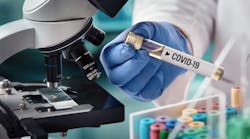The world is treating COVID-19 with a variety of vaccines in hopes of finally stopping the coronavirus. Almost as important is detecting the disease in the first place, and a team from the U.S. Army Combat Capabilities Development Command (DEVCOM) Army Research Laboratory has been working with the Georgia Tech Research Institute, Cardeo Bio, and the University of Georgia on a “positive” means of identifying the disease which often doesn’t manifest symptoms for the first several weeks of infestation. The research team is hoping to develop a prototype sensor that will accurately and repeatedly detect the severe acute respiratory syndrome coronavirus 2 (SARS-CoV-2), the heart-shaped virus that causes the COVID-19 disease (see the figure), quickly and in the air.
The challenge is like isolating a threat signal amidst a crowded signal environment because the pathogens are microscopic and surrounded by other contaminants in indoor and outdoor environments. Army chemist and team leader, Dr. Matthew Coppock, feels that ARL can develop a solution using synthesized peptides that imitate antibodies: “Monitoring pathogens in the environment remains a challenging area of study. ARL has a unique capability to design and synthesize selective biosensor recognition elements using short synthetic peptides, called Protein Catalyzed Capture agents, which mimic the attachment mechanism of antibodies.”
By working with Georgia Tech, ARL will provide PCC receptors for SARS-CoV-2 that will be integrated into sensor hardware, hopefully leading to a device capable of public-health monitoring for the coronavirus and re-opening of public places and travel. “ARL’s biodetection technology is a crucial enabler for persistent biosensing in operational environments,” Coppock said. “The unparalleled thermal and biological stability of the receptors will allow a significantly longer sensor shelf-life and the elimination of cold-chain shipping/storage, a necessity for performance in Army working conditions.”
The PCCs are a fraction (about 1/60th) the size of antibodies, enabling high detection sensitivity of COVID-19 as well as any new and emerging biological threats faced by soldiers in the field. The sensors must be manufactured with minimal sensor-to-sensor and batch-to-batch variations to ensure accurate readings. The sensors are being designed to detect and capture pathogens for further study, with enough versatility, as Coppock says, for many applications: “This capture component ideally can be incorporated into any biological detection device, such as test strips or graphene-based detectors, like the one being developed.”
